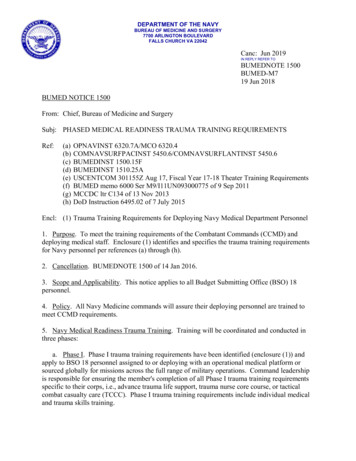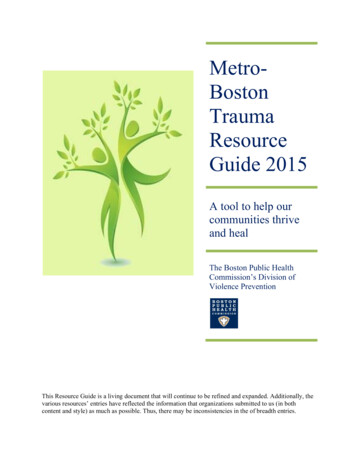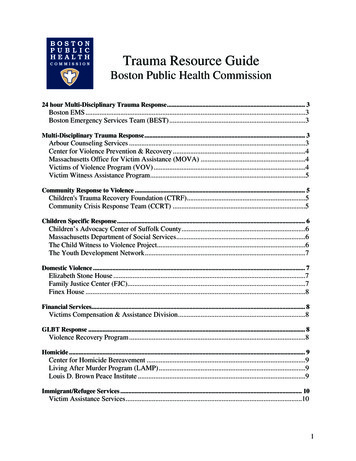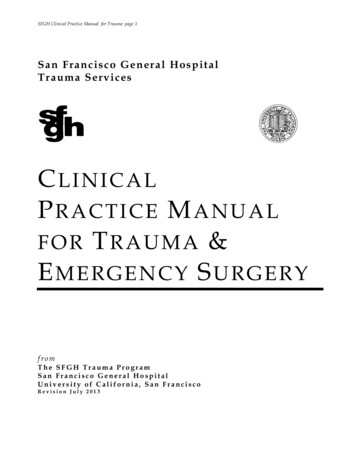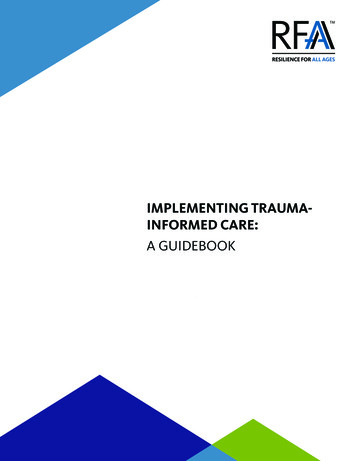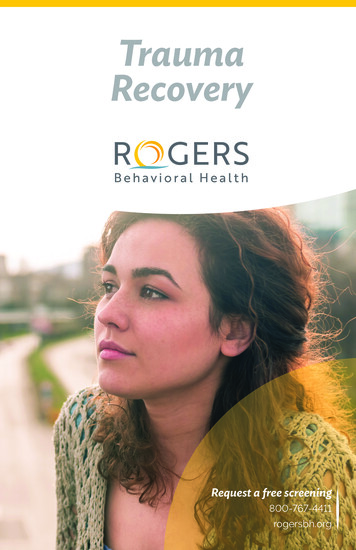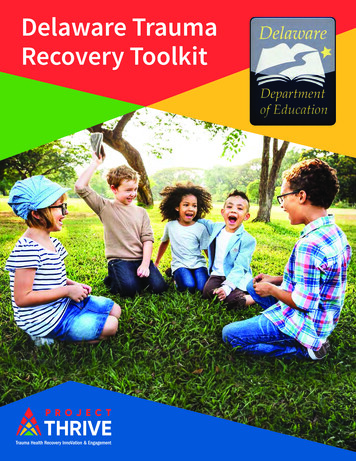
Transcription
Delaware TraumaRecovery Toolkit
Delaware TraumaRecovery Toolkit
Delaware TraumaRecovery Toolkit
Delaware TraumaRecovery Toolkit
Delaware TraumaRecovery Toolkit
STAGE1MAKINGDELAWAREA TRAUMAINFORMEDSTATEMAKING DELAWAREA TRAUMA INFORMEDSTATEOn October 17, 2018, Governor John Carneysigned Executive Order 24, to make Delaware aTrauma-Informed state. The Executive Order addressesthe impact of various kinds of trauma across thelifespan and multiple life domains.Through a generous grant from the DelawareDepartment of Education, Project THRIVE wascreated to help children suffering Adverse ChildhoodExperiences (ACEs) receive Trauma Informed supportfrom their schools, community and caregivers.
WHAT ARE ADVERSECHILDHOOD EXPERIENCES?TOXICProlonged activation of stressresponse systems in the absence ofprotective relationships.When a child feels intensely threatened by an event they’ve experiencedor witnessed, that event is traumatic. In clinical terms, it is known as“Adverse Childhood Experiences,” or ACEs for short. ACEs can take onmany forms and affect children of any socioeconomic status.TOLERABLETo clarify, trauma does not include every “upsetting experience.” Allchildren experience unpleasant and scary events that affect them—suchas their parents’ divorce—but that does not necessarily mean those eventsare traumatic. On the flip side, experiences that are considered just part ofeveryday life for an adult—e.g., ongoing stress, living in a bad neighborhood,bullying, etc.—can potentially have lasting negative effects on a child.2POSITIVESerious, temporary stress responses,buffered by supportive relationships.Brief increases in heart rate, mildelevations in stress hormone levels.In this toolkit, we take an indepth look at: Types of childhood trauma. How each type can affect a child’s confidence and development. Warning signs to keep watch for.Most importantly, it includes the tools to help both yourself and thechild practice coping and resilience.Project THRIVE is an initiative supported by the Delaware Department ofEducation to help children suffering from toxic stress—due to severe andongoing trauma—learn resilience, strength and coping strategies.WHAT IS TOXIC STRESS?From an evolutionary standpoint, stress is a good thing. In fact, stressand the “fight or flight” response associated with it are what haveallowed humans to survive and flourish for millenia. However, toxicstress, or the “strong, frequent or prolonged activation of a person’sstress response system,”30 can have long lasting effects on a child’shealth, behavior and ability to learn.8Delaware Trauma Recovery ToolkitWhen a child is constantly exposed to maltreatment or abuse, their stress response system is triggered more frequentlyand for longer periods of time. Living in a consistent state of extreme stress can actually change a person’s brainstructure—leading to a slew of physical, emotional, developmental, behavioral and societal problems.WHAT DOES TRAUMA INFORMED MEAN?Trauma-Informed means we train our teachers, guidance counselors and other DDOE staff to assume that when a child isacting out or behaving inappropriately, they are more likely than not to have a history of trauma. Trauma-Informed Carerecognizes the presence of trauma symptoms and acknowledges the role trauma may play in a child’s life—teaching ourstaff the life-long benefits of positive child protective factors and behaviors.The next section in this toolkit will give you a Trauma Informed overview of different types of ACEs, signs to look out for,and ways to help. If you would like more information about any of the information presented in this toolkit, you will find alist of resource links at the end of this document.STAGE 1: MAKING DELAWARE A TRAUMA INFORMED STATE9
TYPES OF TRAUMASTAGE2There are 15 distinct and recognized types of childhood trauma.1 To learn more about each, clickon the icon to be taken directly to that GNIZING&SUPPORTINGSURVIVORSOF ALDISASTERSREFUGEE CE TERRORISMAND VIOLENCECOVID-19TRAUMA
BULLYINGBullying takes on many forms. All are equally dangerous and damaging.Physical Bullying Kicking Hitting Punching Slapping Shoving Other physical acts.4Verbal Bullying Relentless insults Demeaning language Belittling othersEFFECTS AND SIGNS OF BULLYINGRelational Aggression Ostracization Manipulative situations Rumors and sabotageCyberbullying Online threatsPosting hurtful picturesMaking derogatory commentsSending hurtful emails and/or textsSexual Bullying Harmful and humiliating actions that repeatedlytarget a person’s sexuality Vulgar gestures Uninvited touching Being forced to lookat pornographic materialsSexual propositioningCrude commentsSexual name-callingIn extreme cases, sexual bullying can open the door to sexual assault.412Delaware Trauma Recovery ToolkitRemember tocontinuallyencourage the child,and direct themtoward positiveinfluences andactivities that willhelp them rebuildthe confidence thattheir experienceswith bullying mayhave chipped away. Stress, anxiety, depression and feelings of loneliness and isolationSchool avoidance and/or poor academic performanceBecoming easily angered or frustratedSeparation anxietyLow self esteem or feelings of rejection that could lead to self harmHealth complaints and/or eating disordersPoor relational skillsSuicidal or homicidal ideations or actionsHOW TO HELPAlways take bullying seriously and turn to teachers, counselors and other schoolofficials for help. Remember to continually encourage the child, and directthem toward positive influences and activities that will help them rebuildthe confidence that their experiences with bullying may have chipped away.RESOURCESFor more information, please refer to these at-is-bullyingSTAGE 2: RECOGNIZING & SUPPORTING SURVIVORS OF TRAUMA13
COMMUNITY VIOLENCECOMPLEX TRAUMAThis type of trauma is the result of hostile and violent surroundings in which the child lives and is defined as “exposure tointentional acts of interpersonal violence committed in public areas by individuals who are not intimately related to thevictim.”7 Examples of adverse childhood experiences (ACEs) associated with community violence are witnessing fightsbetween rival gangs, robberies, shootings in public areas, terrorist attacks, drug violence and other “war like conditions,”which children very susceptible to experiencing ongoing toxic stress.8Children learn about the world through the experiences they have withtheir caregivers. It is through their caregivers they learn to regulatetheir emotions, control their actions, trust others and interact with theworld around them. These interactions shape their perception of thatworld and their place in it. Children with neglectful or abusive caregiversbelieve the world is a scary, terrible place and that they must be bad forthis neglect and abuse to be happening to them.EFFECTS AND SIGNS OFCOMMUNITY VIOLENCEMany children can become: Withdrawn Untrusting Depressed ViolentRepeated trauma can lead to major changes inpersonality and behavior8 and PTSD symptoms can havesignificant negative impact on: Learning and developmentMental and emotional wellnessBehaviorPhysical healthHOW TO HELPEFFECTS AND SIGNS OF COMPLEX TRAUMABe a safe presence the child can rely on. This includeshaving a safe and reliable home routine as well asteaching children the areas that are safe versus those thatare not safe, encouraging them to hang out with otherswho are good influences and making sure they know ofthe resources available to them through Project THRIVE.When family relationships are unstable or unpredictable—if the childis regularly neglected, exploited, abused or assaulted by a caregiver orcaregivers—children quickly learn they cannot rely on them for help. Assuch, many abused and neglected children find it difficult to develophealthy relationships with or attachments to others.RESOURCESEffects and signs of complex trauma can be:For more information, please refer to these resources: Physicalhttps://www.samhsa.gov/trauma-violence Emotional AcademicHOW TO HELPSeeking help for the child begins by seeking help for their caregiver/abuser. Fostering healthy communication, self-regulation and positiveexperiences are all things a counselor or social worker can help with.Don’t be afraid to reach out for help.RESOURCESFor more information, please refer to these resources:14Delaware Trauma Recovery ToolkitWhen familyrelationshipsare unstable orunpredictable—ifthe child is regularlyneglected, exploited,abused or assaultedby a caregiver orcaregivers—childrenquickly learn theycannot rely onthem for help.https://video.search.yahoo.com/search/video; ylt AwrEzeb5sZFgZF4AuJRXNyoA; ylu Y29sbwNiZjEEcG9zAzMEdnRpZANDMTYwOV8xBHNlYwNzYw-?p complex trauma in schools&fr mcafeeSTAGE 2: RECOGNIZING & SUPPORTING SURVIVORS OF TRAUMA15
EARLY CHILDHOOD TRAUMAFrom the moment of birth, a child begins to learn about the world around them. Very young childrenhave rapidly developing brains. Traumatic events have a profound impact on their development,specifically on their brain cortex, which is respons ible for complex functions such aslanguage, perceptual awareness, memory, thinking and consciousness. Youngchildren exposed to trauma are often unable to communicate or regulatetheir actions or emotions. This leads them to behave in ways mostadults are ill-equipped to respond to.10Young childrenexposed to traumaare often unableto communicateor regulatetheir actions oremotions.EFFECTS AND SIGNS OF EARLYCHILDHOOD TRAUMAInfant to 2-year-olds: Screaming or crying incessantlyPoor appetite, low weight or digestive problemsPoor verbal skillsMemory and cognitive problemsThree to six-year-olds: Lack of impulse control / lashing out Lack of self confidence / self blame Difficulty focusing or learning(possibly developing learning disabilities) Trust issues / inability to form friendships16Delaware Trauma Recovery ToolkitThe number onething you can do tohelp a child in theevent of a naturaldisaster is to bepreemptive and asprepared as possiblefor one. Chronic headaches or stomach aches Imitating the abuseHOW TO HELPThe good news is children are resilient. But, thatresilience only has a chance of developing when achildrens’ caregivers are positive, caring and protective,consistent, dependable and safe. Encourage children totalk to you about their experiences, and always reassurethem of your—and the other adults in their lives—abilityand desire to keep them safe.10RESOURCESFor more information, please refer to these ma/traumatypes/early-childhood-traumaNATURAL DISASTERSNatural disasters, known as Acts of God, can be horrific and devastating. Theycan lead to many adverse effects for entire communities, including children.Examples of natural disasters include: FloodsExtreme Heat/DroughtWinter storms/BlizzardsHurricanes LandslidesAvalanchesTornadosWindstoms Tsunamis Earthquakes WildfiresEFFECTS AND SIGNS OF NATURAL DISASTERSWhile most children have shown their resilience after natural disasters,those who suffer greater losses—e.g., their homes, a family member,displacement—may experience PTSD. Let your child know it is okay to feelscared and that there are people in their life to help and support them.HOW TO HELPThe number one thing you can do to help a child in the event of a naturaldisaster is to be preemptive and as prepared as possible for one. Offer themcomfort and reassurance, letting them know everything will be okay.RESOURCESFor more information, please refer to these l-disastersSTAGE 2: RECOGNIZING & SUPPORTING SURVIVORS OF TRAUMA17
MEDICAL TRAUMARather than just being afraid of the doctor or getting shots, medicaltrauma is an intense reaction, which can vary from functioning todisruptive, to the subjective experience—more so than the objectiveseverity—of a medical event. These feelings are typically present in thepatient receiving treatment, but could just as intensely manifest in thepatient’s parent, sibling, or child.EFFECTS AND SIGNS OF MEDICAL TRAUMABehaviors to watch out for include complaints of feeling sick that arenot connected with their illness (e.g., phantom headaches or stomachaches), seeming disconnected or “spacey,” or continuing to developnew or worsening fears as is related to medical events or procedures.A child experiencing medical trauma may also exhibit one or more ofthe following signs:INTIMATE PARTNERVIOLENCE (IPV) Re-experiencingNo longer a “family problem,” IPV is now identified as asignificant legal and public health issue.12 As such, thereis a litany of resources available to help victims of IPV getthe help they need—from finding safety and shelter, totherapy and advocacy, to navigating the legal system.38Children who continually experience domestic violence,even if not the physical victim of the abuse, can experiencesevere psychological impacts from the abuse including: Fear of abandonment Guilt and/or shame for not stopping theabuse witnessed Increased anxietyInability to experience empathyEmotionally distancing themselvesFear of the future or lack of a positive outlookHOW TO HELPFor proper recovery and development, it is essential childvictims of domestic violence have a strong relationshipwith the non offending parent. Strengthening thisrelationship may include various types of interventions,such as group, individual, or one-on-one therapy.If you are the victim of domestic violence, or suspectyou know someone who is, you can reach out to localprograms or turn to Project Thrive for help.RESOURCESFor more information, please refer to these resources:Delaware Trauma Recovery ToolkitHospitals are scary places, especially for a child. Remember to bepatient and understanding. Oftentimes, it is the idea of the unknownthat is most frightening, so do your best to help keep the childinformed. Be honest about everything that is happening and explainhow it will help them feel better. You should introduce them to thehospital staff and encourage them to ask questions.As children are generally more affected by medical trauma when leftalone, try to make sure a family member or other familiar, trusted adultis with them at all times. If you need to leave them unattended, besure to let them know you’re leaving, why, and when you will be back.Encourage your child to talk about their feelings. Remind them that it isokay to feel sad or scared and that you’re there to support them.13programs or turn to Project Thrive for help.RESOURCESFor more information, please refer to these om/watch?v dI tingviolence/fastfact.html18 Hyper-arousalHOW TO HELPAlso known as domestic violence, intimate partnerviolence (IPV) occurs across all races, sexualorientations, socioeconomic statuses, backgroundsand education levels. It is the physical, emotional,financial, sexual, spiritual or verbal abuse against acurrent or former intimate partner to exert power andcontrol. Victims can be harassed, terrorized, humiliated,manipulated, injured, or isolated—but it is often childrenwho are the silent victims of such treatment.11EFFECTS AND SIGNS OF IPV AvoidanceSTAGE 2: RECOGNIZING & SUPPORTING SURVIVORS OF TRAUMA19
Emotional/Mental Signs Inability to form friendships or make connections with others. Hostility toward others, evenfriends and family members. Trouble concentratingDepressionSuffering academic performance Low self-esteemApathy or an air of not caringwhat happens to themInability to effectivelycommunicate or awkwardresponses to basic social cuesAggressionHOW TO HELPIf you suspect a child is suffering from physical abuse, take action assoon as possible. The longer the abuse continues, the more likely thechild will suffer from toxic stress—which could lead to PTSD and a slew ofother physical, emotional and societal effects. The number one concernis to ensure the child’s safety and provide medical care if necessary. Childprotective agencies and pediatricians are trained to properly handle thesesituations and ensure both the child and the abuser get the help they needto end the cycle of violence and engage in positive interaction strategies.RESOURCESFor more information, please refer to these resources:PHYSICAL s/physical-abuse-traumaThe second most common form of child maltreatment, physical abuse is when a parent or caregiver commits an act thatresults in the physical injury of a child.16 Injuries include bruises, marks, welts, cuts, sprains, fractures and broken bones.15Parents and caregivers are supposed to make children feel safe, loved, protected and provided for. However, if that corerelationship is marred by violence, the effects it has on children can be profound—both physically and mentally.14EFFECTS AND SIGNS OF PHYSICAL ABUSEVictims of physical abuse can experience effects that reach well into adulthood, including hearing loss and brain damage.These effects can lead to cognitive delays and emotional issues, leaving them more at risk for developing a mental illness,becoming homeless, or engaging in criminal activity.14Physical signs Injuries to the child that are common or frequently occuring(without the child appearing to be excessively clumsy or accident prone) Implausible explanations or changing/conflicting excuses for injuries Injuries that do not seem to be healing or to have been given medical care Recurring or compounding injuries Habitual tardiness or extended absences without credible reasons/explanations Wearing long-sleeved or otherwise unseasonable articles of clothing to conceal and hide injuries Awkward movements, limps, pain or discomfort from repeated injuries20Delaware Trauma Recovery ToolkitParents and caregiversare supposed tomake children feelsafe, loved, protectedand provided for.However, if that corerelationship is marredby violence, the effectsit has on childrencan be profound—both physicallyand mentally.14STAGE 2: RECOGNIZING & SUPPORTING SURVIVORS OF TRAUMA21
REFUGEE ANDMIGRANT TRAUMAA migrant is someone who has temporarily left their home in search ofwork and better opportunities. A refugee is someone who is outsidetheir home country.In addition to experiencing horrors, atrocities and/or poor conditions intheir own home countries, many refugees and migrants are overwhelmedand uniquely stressed while trying to adapt to their new lives in America.EFFECTS AND SIGNS OF REFUGEE TRAUMAWhile all children react to trauma in their own ways, a preschooler isgoing to behave and react differently than a grade schooler or teenager.Examples of these different behavioral issues include:Preschoolers: Behaving aggressively by biting, kicking, punching, throwingor hittingTemper tantrumsBeing needy or having trouble being away from parentsBehavior regression, including thumbsucking or bedwettingTrouble making friendsReenacting the abusive or traumatic events in playGrade Schoolers: Extreme mood swings or irrational behavior, like lashing out inanger or withdrawing from others in sadnessTrouble academically and socially with peersConstantly anxious or fearful that something bad will happento them or their parentsPre-teens and high schoolers: Feelings of guilt or shame that they couldn’t do more to help inthe situation22Delaware Trauma Recovery ToolkitRemember tocontinuallyencourage the child,and direct themtoward positiveinfluences andactivities that willhelp them rebuildthe confidence thattheir experienceswith bullying mayhave chipped away. Inability to see a future for themselves aswell as feelings of helplessnessLoss of faith or changes in their perception of the worldRelationship issues with family, friends, peers and authority figuresHOW TO HELPWhen assessing the health—mental or physical—of a refugee child, it isimportant to get a thorough trauma history and to understand the role thatculture plays in behavior. Bringing those behaviors into the discussion canhelp direct the conversation toward the differences or disabilities that may beimpeding their progress.RESOURCESFor more information, please refer to these rauma.org/https://www.jfsdelaware.org/STAGE 2: RECOGNIZING & SUPPORTING SURVIVORS OF TRAUMA23
sexual abuse cases committed by women being 14 percent against boysand 6 percent against girls.21EFFECTS AND SIGNS OF SEXUAL ABUSEAs with many of the other types of trauma outlined in this toolkit,children who experience sexual abuse may exhibt the followingbehaviors or characteristics:22 Sexual abuse can be very confusing for children.22 Some may think it istheir fault the abuse is happening, and that something must be wrongwith them. Most children know that the sexual abuse is wrong and oftenexpereince fear, anger, disgust and shock. However, some children—especially those without a loving or dependable primary caregiver—mayconfusedly enjoy the attention and closeness that they do not receive inother parts of their life.21SEXUAL ABUSEThere are many definitions of sexual abuse as it is a pernicious,varied and an insideous type of abuse that takes many forms. Generally,it is agreed that sexual abuse is any sexual act, overt or covert, betweena child and adult (or older child, where the younger child’s participationis obtained through seduction or coercion) in which the child is used forsexual stimulation of the perpetaror or observer.19 The abuse can includetouching or non-touching behaviors.20Touching Behaviors Sexual kissing Touching Fondling of genitals Oral/anal/or vaginal intercourseNon-touching Behaviors Genital exposure or flashingVerbal pressure for sexForcing children to watch pornographyExplotation for prostitution, trafficking or pornographyAbout 30 percent of all child sexual abusers are relatives of the victim,with strangers only accounting for about 10 percent. Most sexual abuseis perpitrated by men; however women are perpetrators as well, with24Delaware Trauma Recovery ToolkitWithdrawn behaviorAngry outburstsInability to sleep well, often suffering from nightmaresAnxiety and/or depressionPlay re-enactments of the abuseSexual behavior, knowledge or language that does notmatch the child’s ageNot wanting to be near or alone with certain personsHOW TO HELPAbout 30 percent of allchild sexual abusers arerelatives of the victim,with strangers onlyaccounting for about10 percent. Most sexualabuse is perpitrated bymen; however womenare perpetrators as well,with sexual abuse casescommitted by womenbeing 14 percent againstboys and 6 percentagainst girls.21While many children do exhibit the signs of abuse outlined above, notall show signs of distress. The most important thing you can do is teachyour child about body health, safety and boundaries. Having open andhonest conversations with your child about sexual matters will enablethem to recognize safe-touching versus what crosses the line and makesthem feel unsafe or uncomfortable. These conversations are meant toeducate and empower your child and can prevent them from fallingvictim to sexual predators.22If you know or suspect a child in your life has experienced sexual abuse,the first course of action is the ensure the child’s safety. Turn to ProjectThrive or other local programs and resources that can help you get thechild the help they need and deserve.RESOURCESFor more information, please refer to these AGE2: 2:RECOGNIZINGIDENTIFYING& SUPPORTINGAND HELPINGSURVIVORSVICTIMS OFOFTRAUMATRAUMA25
SEX TRAFFICKINGA severe form of sexual abuse, child sex trafficking is the giving orrecieving of anything of value (e.g., money, food, shelter, clothing,drugs, etc.) to any person in exchange for a sex act with someone under18-years-old.23 It includes the recruitment, harboring, transportation,provision, obtaining, patronizing or soliciting of a person under the ageof 18 for the purpose of a commercial sex act.24 Child sex trafficking isalso known as Commercial Sexual Exploitation of Children or CSEC.24However, there does not have to be a third party that benefits from thetransaction for it to be child sex traffcking.Because it is called “sex trafficking,” many associate it with children beingkidnapped by scary-looking strangers and smuggled across borders—constantly moved around from place to place to avoid detection.However that is rarely the case—even though it can happen that way.24The sad fact is that most of the children in these circumstances are morelikely to know or even be related to their exploiters.EFFECTS AND SIGNS OFSEX TRAFFICKINGWHO IS AT RISKIn many cases, children aren’t aware they’re beingtrafficked, so it’s important to know the signs to look for.33Some warning signs are children who:Sex trafficking can and does happen among all socioeconomic classes,races, ethnicities and gender identities.25 It can also happen anwhere—in cities, suburbs, small rural towns and tribal communities. However,there are factors that put children at greater risk to betargeted by sextraffickers. They often target children with a history of abuse and/orwho have low self-esteem and who don’t have a strong socialsupport system.3226Delaware Trauma Recovery ToolkitThe sense ofhopelessness childsex trafficking victimscan experience alsoleave them moresusceptible to abusedrugs and alcohol,commit suicide, orlive their lives insocial isolation.49 Aren’t enrolled in/don’t attend schoolDon’t talk about where they live or who they live withSeem to give a rehearsed story about where theylive and who they live withHave possessions that are uncommon or are inpossession of a lot of moneyAre unaware of where they areSpend an unusual amount of time doinghousehold choresLive in substandard conditions at homeSex traffickers often use convoluted manipulation tacticsand a combination of various forms of abuse—such asverbal, physical, emotional, isolation, frequent uprooting,starvation, surveillance—to destroy a child’s will to escape.33The effects of child sex trafficking, from the manipulation tothe exploitation, are detrimental to the victims, socially andpsychologically. Some effects are: PTSD Dissociating Damaged sense of self Problems with emotional regulationImpaired cognitive functionNightmares or flashbacksDepression or anxietyThe sense of hopelessness child sex trafficking victimscan experience also leave them more susceptible toabuse drugs and alcohol, commit suicide, or live theirlives in social isolation.49HOW TO HELPSex trafficking can happen to anyone. These predatorsprey on children they believe are lonely or feel unlovedso never miss an opportunity to remind your childrenhow much you value them. In addition, practicevigilance and monitor your kids’ social media. Helpthem understand privacy and boundaries, and teachthem not to share everything on social media. Childrenwhose posts indicate that they are looking for attentionmake them a very easy mark for predators.RESOURCESFor more information, please refer to these ole-oftrauma-in-human-trafficking/STAGESTAGE2: 2:RECOGNIZINGIDENTIFYING& SUPPORTINGAND HELPINGSURVIVORSVICTIMS OFOFTRAUMATRAUMA27
RACIAL TRAUMARacial Trauma is the mental and emotional injury cause by encounters with racial bias andethnic discrimination, racism and hate crimes.37 In the U.S., Black, Indigenous Peopleof Color (BIPOC) are the most vulnerable due to systematic white supremacy.Racialized trauma can come directly from other people—hate crimes,racial slurs—or systemically from inherent-bias based policies.Try to limit the child’sexposure to mediacoverage—especiallynegative coverage—of the event as it canincrease their fearand anxiety.26Putting your energytoward makingpositive change canhelp provide a senseof purpose and afeeling of connectionwith others who havesimilar experiences.EFFECTS AND SIGNSOF RACIAL TRAUMAProlonged incidents of racism can lead children of colorto experience post traumatic stress disorder. These canbe both physical and psychological. Psychological Depression AngerRecurring thoughts of the event Nightmares Hypervigilance Low self esteemMentally distancingoneselfPhysicalHeadachesStomach achesInsomniaHOW TO HELP 39When dealing with ongoing trauma, self care is vitallyimportant. Make sure to prioritize taking care of your andyour child’s mental and physical needs by eating28Delaware Trauma Recovery ToolkitTERRORISM AND VIOLENCEActs of terroriosm and violence affect us all. Some are so heinous, like9/11, Pearl Harbor, and the Kenney assassination, they define and shapegenerations. Those events stopped the world, and those who lived throughthem clearly remember where they were when they heard the news.regularly, getting adequateamounts of rest, and distancingyourself from social media, the news media, andother sources of distressing information.Participating in community activism is a great way toconnect with other like minded individuals. Putting yourenergy toward making positive change can help provide asense of purpose and a feeling of connection with otherswho have similar experiences. You can also turn to ProjectTHRIVE for professional help and more information aboutthe resources available for you and
recognizes the presence of trauma symptoms and acknowledges the role trauma may play in a child's life—teaching our staff the life-long benefits of positive child protective factors and behaviors. The next section in this toolkit will give you a Trauma Informed overview of different types of ACEs, signs to look out for, and ways to help.


